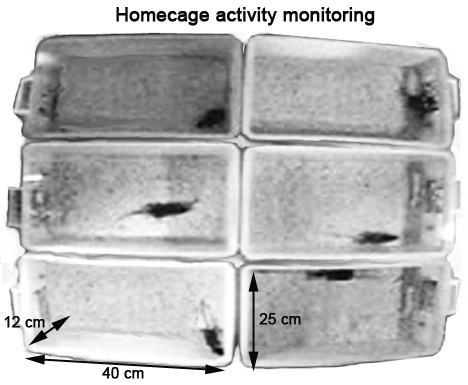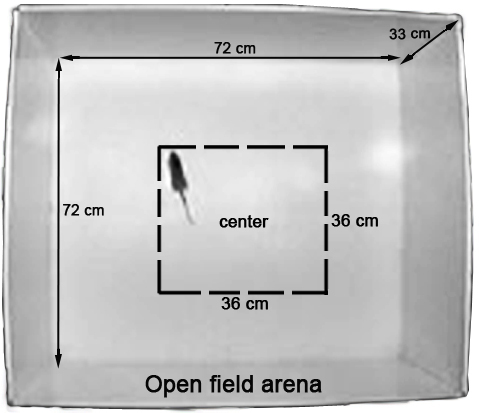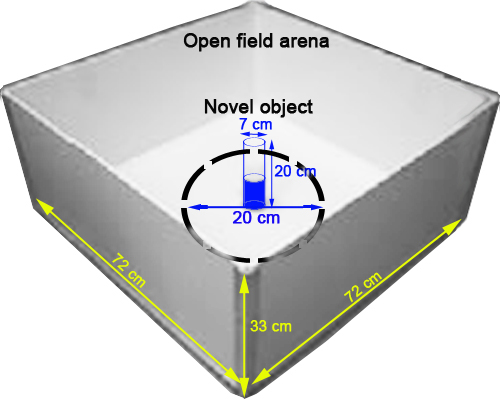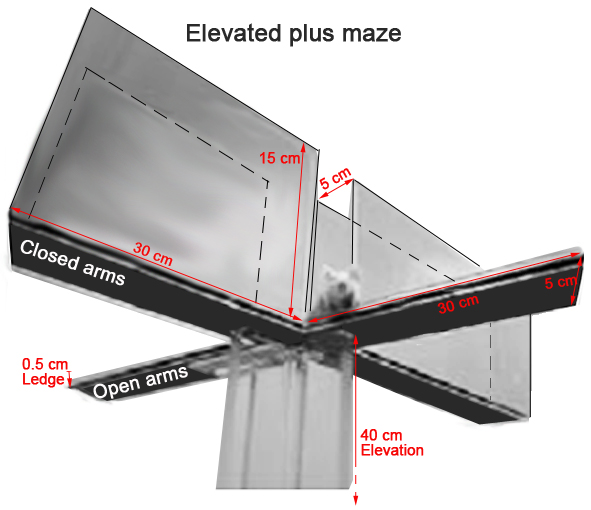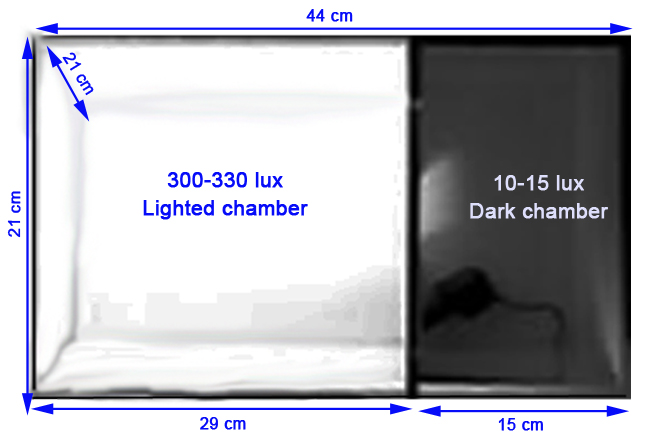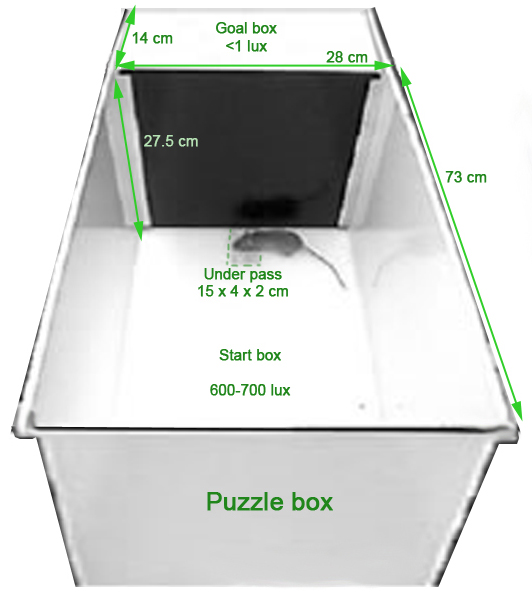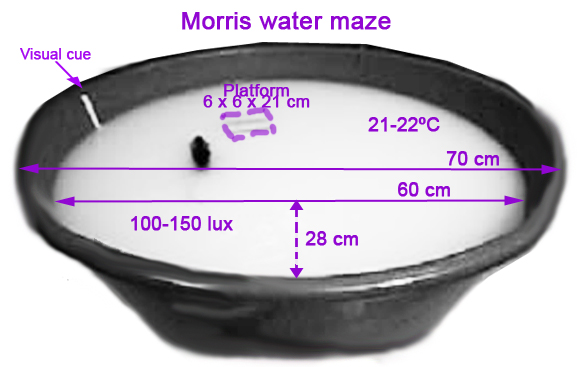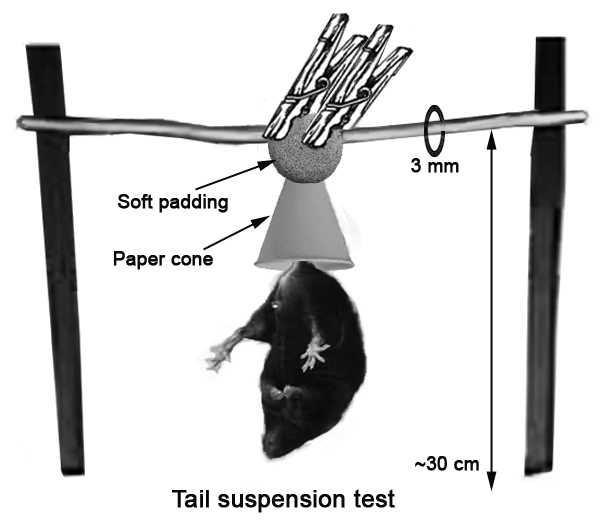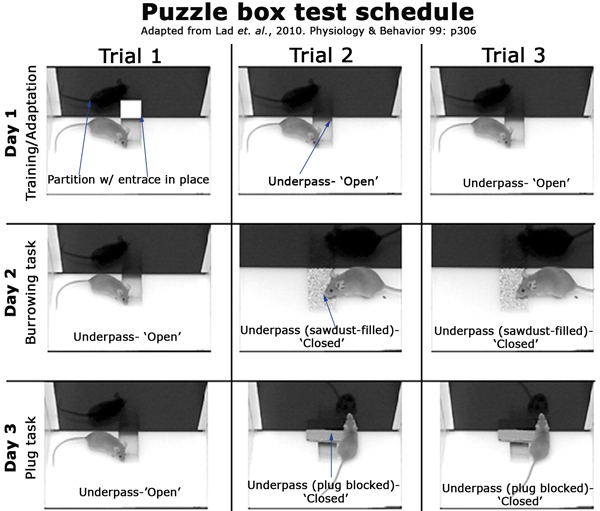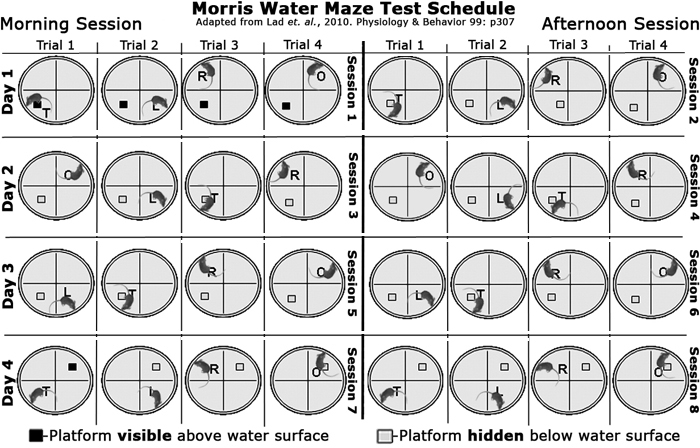Schalkwyk1 project protocol
Battery of behavioral testing in males of 8 inbred mouse strains (2010)
Schalkwyk LC, Fernandes C, Kember R, Lad HV, Liu L, Parsons MJProject protocol — Contents
Workflow and sampling
Equipment
Reagents, supplies, and solutions
Procedure for conducting a battery of behavioral tests:Open field test
Novel object test
Elevated plus maze
Light-dark box
Puzzle box
Morris water maze
Tail suspensionWorkflow
Exploratory behavior is assessed in the presence of a novel object and under bright illumination Anxiety and exploratory behavior is assessed under dark and bright illumination Learning, memory, and use of spatial cues to escape bright illumination is assessed Learning, memory, and use of spatial cues to locate a visible and a hidden platform is assessed • Homecage and automated tracking EthoVision software (Figure 1)
Figure 1. Dorso-ventral view of 6 home cages.
• Open field arena: custom-built, white acrylic (72x72x33 cm, Figure 2)
Figure 2. Dorso-ventral view of the open field arena.
• Novel object (Figure 3)
Figure 3. A novel object placed within the open field apparatus for the novel object exploration task.
• Elevated plus maze (Figure 4) constructed from black opaque acrylic, with each arm measuring 30x5 cm and the central platform 5x5 cm. One set of arms, opposing one another, are enclosed completely by a wall of transparent acrylic, 15 cm high, while the other set is open with a ledge of 0.5 cm either side of the arms. The maze is elevated 40 cm from the ground on a transparent acrylic stand.
Figure 4. Ventro-dorsal view of the elevated plus maze apparatus showing the transparent acrylic closed arms ('safe zone') and the open arms ('exploratory zone').
• Light-dark box: custom-built, white acrylic (44x21x21 cm). The box is partitioned unequally with a sheet of white acrylic, 21x50 cm, such that approximately one-third (15x21x21 cm) of the total area is under low lighting (10-15 lux) representing the 'dark chamber,' and the remaining two thirds brightly lit (300-330 lux) with white light, which served as the 'light chamber' (Figure 5). A small opening within the partition, 5x7 cm, allows mice to move freely between chambers.
Figure 5. Dorso-ventral view of the light-dark box showing brightly lit 'light chamber' and the 'dark chamber' where the mouse is hiding.
• Puzzle box apparatus (Figure 6): custom-built, white acrylic (73x28x27.5 cm). The box is unequally partitioned into 2 compartments with a movable black sheet of acrylic, 28x27.5 cm, which designated a "start-box" on one side, 58x28x27.5 cm, and a smaller "goal box" on the other, 14x28x27.5 cm. Two different partitions are used in this test: the first (partition 1) has an entrance cut into the base of it, 4x4 cm, which enables visibility of-and access to-the goal box from the start-box (Figure 9, day 1 and trial 1); the second (partition 2) is merely a partition. An underpass, 15x4x2 cm, is cut into the 2.5 cm thick-base of the apparatus, spanning the partition and allows mice to move between compartments when it is in place.
Figure 6. Dorso-ventral view of the brightly lit compartment of the puzzle box apparatus; mouse enters via underpass into covered goal box compartment.
• A blue circular container made of plastic, diameter 70 cm and depth 28 cm, is used for the Morris water maze test (Figure 7). The container is divided equally into quadrants and the edge marked to designate the following for detailed tracking in EthoVision: right (R), left (L), target (T), and opposite (O). Each quadrant is used to determine the placement of the mouse into the maze which alternated for successive trials (see Figure 9 for detailed illustration). Tap water (21-22°C) is used to fill the container up to a depth of 22 cm, giving a water surface diameter of 60 cm. A non-toxic whitener (80 g of milk powder) is used to color the water. Light intensity across the surface of the water is set to 100-150 lux. A transparent plastic square platform, 6x6x21 cm, is placed in middle of quadrant T (1 cm above for the visible trials and 1 cm below the water during the acquisition phase) for all trials except reversal. For the reversal session, the platform is submerged 1 cm in the middle of quadrant O.
Figure 7. Above view of a Morris water maze container with a visible platform.
• Tail suspension apparatus: A cord (3 mm diameter) is extended and secured between two legs of an upturned chair, at least 30 cm height from the base (Figure 8).
- Cardboard cones
- Soft padding
Figure 8. Schematic illustration of the tail suspension test.
- 70% alcohol
- Disinfectant solution: 1% Trigene®
- Paper towels and other cleaning materials
Procedure for conducting a battery of behavioral tests
Procedures common to all behavioral tests
a. The battery of behavioral tests is conducted in order from the least to most stressful (see workflow above).
b. Each apparatus is wiped clean with 1% Trigene® between subjects to avoid olfactory cueing influencing activity and behavioral performances.
c. Mice are tested in a pseudorandom order and are moved to the behavioral suite adjacent to the housing room immediately before testing with a minimal transfer time.
d. Behaviors for all tests are recorded and archived on videotapes for more detailed analysis.
e. A comparable method of hand coding is used to score locomotor activity in the OF and LD tests for albino mice, since automated tracking for these mice is not readily accessible using EthoVision software.
f. Mice are returned to their home cages at the end of each test.I-Home-cage activity
(data not yet submitted, awaiting publication)II-Open field
a. During testing, white light of 300-330 lux intensity is used to evenly illuminate the entire open field arena.
b. At the start of each test session a mouse is taken from its home cage and placed into a corner of the open field arena, such that it is facing the wall.
c. Open field activity is then video-recorded for 5 min for further analysis using EthoVision.
d. At the end of each open field test, the number of fecal boli and urine puddles are recorded.
e. In order to determine center locomotor activity (cm), duration (s) and frequency in the open field, horizontal movement within a square of equal distance from the periphery or within the designated "central zone" (36x36 cm) is tracked using EthoVision (see Figure 2).
f. Latency (s) to enter the center as well as peripheral locomotor activity (cm) are also measured using EthoVision.III-Novel object exploration
a. The novel object test is performed 48 h following the open field test using the same apparatus (see above for details) to measure the exploratory activity of a mouse in response to a novel object placed within the center of the arena.
b. During each test session a novel object, consisting of a blue metal cylinder, 20 cm height and 7 cm diameter with a white top surface for tracking (see Figure 3), is introduced into the arena.
c. During testing, low white lighting of approximately 30 lux intensity is used to evenly illuminate the entire open field arena.
d. As in the open field test above, a mouse is taken from its home cage and placed into a corner of the open field arena, such that it is facing the wall at the start of each test session.
e. The mouse is allowed to habituate to the testing condition before a novel object is placed in the center of the open field arena 2 min into the test session, after which the mouse is allowed to explore the object freely for the remaining 3 min of the test.
f. A circular area (measuring 20 cm in diameter) around the object is defined and used as the "exploration zone" in EthoVision recorded tracking (see Figure 3).
g. During the final 3 min of exploratory activity, latency to initial exploration of the novel object, as well as the frequency and duration of exploration around the object, and rearing behaviors are recorded.IV-Elevated plus maze
a. Light intensity around the maze is set between 300 and 330 lux.
b. At the start of every elevated plus maze (EPM) task, a mouse is placed on the central platform, facing towards a closed arm, and allowed to explore the maze freely for 5 min.
c. At the end of each elevated plus maze test, the number of fecal boli and urine puddles are recorded.
d. To score behaviors from videotapes of the EPM, EthoLog version 2.25 is used.-When all four paws enter an arm, an arm entry is counted; similarly, when the forepaws are out on an arm, a central entry is counted.
-An arm exit is considered when all four paws leave the arm.e. The following behavioral indices are scored: open and closed arm entries; open and closed arm duration; latency to first enter an open arm; and time spent on the central platform after initial placement.
V-Light-dark box
a. Each mouse is taken from its home cage and placed into the dark chamber facing the end wall (parallel to the partition) except for the group that is used to investigate initial placement in the light, which are placed facing the end wall (parallel to the partition) within the light chamber.
b. Activity in the light-dark box is video-recorded for 5 min.
c. At the end of every light-dark box test, the number of fecal boli and urine puddles are recorded.
d. The latency for each mouse to emerge from the dark chamber into the light chamber is recorded; for the group placed in the light chamber at the start of the test, latency to move into the dark is likewise recorded using EthoLog.
e. Duration in each chamber and the number of light-dark transitions are also hand coded using Etholog. A single transition is counted when all four paws had enter a chamber.
f. Activity within the dark chamber and light chamber are measured using Ethovision, and mean speed is derived from these measures.VI-Puzzle box
The puzzle box is used to demonstrate the motivation of a mouse to solve problems when exposed to a brightly lit arena. It is adapted from the problem solving paradigm for rats in which a series of tasks are presented in order of difficulty. Previous results from submitting investigator's laboratory suggested that "mice employ contextual memory and spatial navigation to solve problems within the puzzle box."
a. During testing light intensity is set between 600 and 700 lux across the start-box, while the goal box is covered with a white acrylic sheet to minimize illumination at <1 lux.
b. A mouse is placed within the start box and the latency to move into the goal box via the underpass is recorded over successive trials.
c. The puzzle box test is accomplished in 3 consecutive days starting with a training session on day 1 (see Figure 9 below):Training Session
Day1/trial 1: only partition 1 is in place (see details above) to separate the start-box from the goal box, through which the goal box is visible.
Day1/trials 2 and 3: the partition 2 is in placed for the remaining trials (see Figure 9), the purpose is for the mouse to learn how to access the goal box via the underpass.
Burrowing Session
Day2/trial 1: the mouse is prompted to enter the goal box via the open underpass.
Day2/trials 2 and 3: the underpass is then filled with sawdust, such that the mouse is prompted to burrow in order to reach the goal box.
Plug Session
Day3/trial 1: the mouse is prompted to enter the goal box via the open underpass.
Day3/trials 2 and 3: the underpass is "plugged" across with a rectangular piece of corrugated cardboard (7.5x2.5x0.5 cm) mounted in place by a cardboard block (2x3x1.5 cm), and the mouse is prompted to learn to remove the plug in order to access the goal box.
d. After initial training session on day 1, the puzzle test is continued with two different problem solving sessions on days 2 and 3 (Figure 9).
e. For each test session, 3 trials with increasing level of difficulty are carried out in succession.
f. Each mouse is taken from its home cage and placed into the start-box facing the end wall parallel to the partition.
g. The latency to enter into the goal box, or when all four paws are in place, is recorded for each trial.
h. The mouse is returned to its home cage between trials, or after a maximum of 3 min trial duration.
i. Mean latencies are calculated for the training, burrowing and plug sessions as an index of the problem solving abilities of each mouse across the given tasks.
Figure 9. Scheduled tasks for the puzzle box. Day 1 initial training phase for learning acquisition, followed by Day 2 problem solving burrowing task, and Day 3 problem solving plug task. Underpass is "open" when it is not obstructed. Underpass is "closed" when it is blocked or obstructed by sawdust or solid plug.
VII-Morris water maze
a. Each mouse is trained to remember the location of the initially visible platform that is subsequently submerged in water during acquisition. A reduction in the latency to localize the platform over successive trials is indexed as learning.
b. Each mouse is taken from its home cage and placed into the water maze at the designated quadrant facing the wall, and allowed a maximum of 60 s to locate the platform. A quadrant sequence is pre-determined for placement of the mouse into the maze across trials per session (see Figure 10 for detailed illustration).
c. After 60 s in the water maze, the mouse is guided to the platform with the use of a wooden plank (26x4.5x1 cm), and returned to its home cage.
d. The inter-trial interval is set at approximately 6 min.
e. On the final test day of reversal session or "reversal" learning task, the platform is submerged 1 cm in the middle of quadrant O (opposite), whereby the location of the platform is moved to a different quadrant (O) of the pool, thereby measuring the flexibility of spatial orientation via the ability to rapidly and accurately learn the new location of the platform.
f. Latency to reach the platform with all four paws is recorded for each mouse:
• Training Phase
Day1/Session 1: the platform is visible 1 cm above the surface of the water, for each trial.
• Reversal Task
Day1 to Day3/all trials in Sessions 2-6: the platform is submerged 1 cm beneath the surface of the water.
Day4/Sessions 7 and 8: the platform is placed in quadrant O, diagonally opposite the original placement quadrant T (see Figure 10 below); and the wooden plank is initially placed on the platform for trial 1 of session 7 to indicate its new location.
g. In order to obtain session performance per mouse, mean latencies are calculated across the trials per session for each mouse. The Morris water maze testing is accomplished within 4 consecutive days, with 2 sessions (morning, afternoon) per day, each session consisting of 4 trials for a final total of 32 trials.
Figure 10. Morris water maze test schedule. The maze is divided into 4 equal quadrants as indicated by each circle: right (R), left (L), target (T), and opposite (O)- used to designate the initial placement of the mouse into the maze. A sequence is pre-determined and remained the same across morning and afternoon sessions. A square platform is placed in the T quadrant for all trials on days 1-3, and is placed in quadrant O for the reversal sessions on day 4. The visible (black square) platform is 1 cm above the surface of the water during training in session 1, and 1 cm below the surface during acquisition (gray square) in sessions 2-6. Schematic illustration is not drawn to scale.VIII-Tail suspension test
a. Two separate trials of the tail suspension test are performed on each mouse at approximately the same time of day on consecutive days, with a minimum of 24 h between trials.
b. A cardboard cone is placed around the tail of each mouse immediately before the test, with its tail extending through the tip, to prevent tail climbing behaviors.
c. The mouse is suspended at approximately one-third from the end of its tail, using soft padding around the area to protect the tail, and plastic clothes pegs are used to secure the mouse to the line (Figure 8).
d. Each trial is 5 min long and analyzed using the mobility detection module in EthoVision.Definitions
The novel object test is performed using the same apparatus as the open field test to measure exploratory behavior in the absence and presence of a novel object placed within the center of the arena.
Puzzle box is adapted from the problem solving paradigm for rats (Lad et. al., 2010) in which a series of tasks are presented in order of difficulty. The puzzle box is also devised to demonstrate the motivation of a mouse to solve problems, employing contextual memory and spatial navigation, when exposed to a brightly illuminated arena for which it is driven to escape.
The Morris water maze test is designed to test the spatial learning ability and memory of a mouse across several trials, run over a number of days, using visual cues placed around a water-filled maze. Initially a mouse is trained to remember the location of a visible platform that is subsequently submerged in water during acquisition phase. Learning index is deduced from reduced latency to locate platform over successive trials. On the final day a "reversal" learning task is included to measure the flexibility of spatial orientation via the ability to rapidly and accurately learn the new location of the platform.
Data collected and submitted by investigator
Open field test: total activity (center, periphery, rearing in presence of novel object), exploratory behavior in the absence and presence of a novel object (center square occupancy).
Elevated plus maze: exploratory behavior (open arms occupancy, duration in center); anxiety behavior (closed arms occupancy).
Light-dark box: exploratory behavior (light zone occupancy)
Puzzle box: behavioral learning and memory via latency to reach goal (training period, burrowing task, plug task).
Morris water maze: behavioral learning and memory via latency to reach visible and hidden platform and latency to reach reversed platform.
Tail suspension test: stress reactivity (duration of immobility).
References
Parsons MJ, Grimm CH, Paya-Cano JL, Sugden K, Nietfeld W, Lehrach H, Schalkwyk LC. Using hippocampal microRNA expression differences between mouse inbred strains to characterise miRNA function. Mamm Genome. 2008 Aug;19(7-8):552-60. Epub 2008 Jul 2.
PubMed 18594913 FullTextSmith RG, Kember RL, Mill J, Fernandes C, Schalkwyk LC, Buxbaum JD, Reichenberg A. Advancing paternal age is associated with deficits in social and exploratory behaviors in the offspring: a mouse model. PLoS One. 2009 Dec 30;4(12):e8456.
PubMed 20041141 FullText
